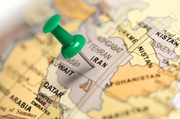Crop pattern, which is defined as the spatial representation of crop rotations, or as the list of crops that are being produced in an area and their sequence in time, has been among the major challenges for Iran’s agricultural sector in the past years.
Regarding the issue, Mr. Bo Zhou, an agricultural officer at FAO Regional Office for Asia and the Pacific has sat for a talk with Mehr News agency.
Here is the full text of his interview:
What is the exact (accurate and true) definition of crop pattern?
Cropping pattern refers to the proportion of area under different crops at different points of time. It also indicates the time and spatial arrangement or sequence of crops and / or fallow in a particular land area. This implies that any change in cropping pattern would indicate (1) a change in the proportion of land under different crops (2) a change in time and space sequence of the crops.
We can differentiate between time and space sequence by following examples:
By time sequence: crop rotation, e.g., an example of soybean after winter wheat in temperate areas
By space sequence: intercropping between maize and potato
If the land is occupied by one crop during one season, the cropping pattern would be Monocropping. [space sequence]
It is not necessarily true. Monocropping refers to growing the same crop year by year without rotation with other crops in the same land.
If the land is occupied by one crop during one season and next season and next to next season (same crop grown year after year), the cropping pattern would be monoculture. [Time sequence] Yes, it is true.
If more than one crop are grown in succession within a year on a field, it’s called multiple cropping. If these are two crops, it is called double cropping. Yes, it is true.
In your view, which technical and scientific requirements are essential to develop and implement an appropriate (locally fitted) crop pattern?
Depending on the crop types, land/soil fertility, other natural resource availability and weather conditions favorable for crop production. The disease and pest cycle could be another concern to develop and implement an appropriate crop patter
Could you please share some tangible examples of countries that have successful records in developing and implementing crop pattern?
The row-intercropping between corn and potato have been commonly practiced to promote the production of both crops in some medium altitude areas in Indonesia and China
Mungbean is widely incorporated in the crop rotation with winter cereals or summer crops in Australian. Wheat/corn, wheat/soybean, wheat/rice, rape/rice rotations are commonly practiced in different parts of China.
How could international organisations, such as FAO, support and assists the countries in developing and implementing crop pattern?
FAO supports the countries to develop and implement different crop pattern to attain the productivity and sustainability through the implementation of various field projects. For example, the ongoing GEF7 project in China aims to support different cropping patterns including wheat/corn, wheat/rice, rice/rice double cropping and monocropping to intensify the crop production and improve sustainability in China attain the productivity of crops
In your view, how and to what extent it is expected that the development and implementation of crop pattern can contribute to improving the countries’ agricultural sections and empowering agricultural activists (farmers)?
The benefits of different cropping patterns adopted in the crop production are mainly consisted of:
1) Increase the productivity of the same land for food and nutrition security and livelihood improvement
2) Increase the sustainability of crop production to maximize the utilization efficiency of the natural resource. For example, the incorporation of the legume crops with cereal crops can help to improve the soil fertility by nitrogen fixation by legume crops.
3) Disrupt the disease and pest cycle by crop rotation or intercropping
4) Promote a mechanization strategy, which can reduce the labour dependency and drudgery in crop production, including facilitating local machinery production and maintenance which would create jobs in rural areas
How could governments persuade/urge the farmers to implement the recommended crop patterns?
1) Enabling policy including financial incentives to advocating the implementation of suitable cropping patterns for attain the crop production and productivity. For example, the incorporation of green manure crops with other crops could be promoted if subsidize can be provided by the government.
2) Service provision and maintenance for mechanization agriculture, particularly conservation agriculture machineries, is critical
3) Availability and accessibility of suitable varieties of different crops in the cropping pattern
4) Farmers and extension workers’ capacity building and awareness raising
How do you assess the feasibility to implement crop patterns in Iran?
Iran is rich in different agro-ecological zones. Based on the different agro-ecological factors, such as weather (temperature, rainfall, etc.), soil characteristics and fertility, water and other natural resources, the crops suitable for different agro-ecological zones can be mapped and tested. Based on the crop season, growth period, and output of interaction of different crops, the cropping patterns for different agro-ecological zones can be further developed and implemented. For example, in a new wheat project in Iran, the wheat/soybean cropping pattern is to be developed and implemented to promote the production of both wheat and soybean in the country.
What requirements does Iran need to be equipped with in order to develop and implement crop pattern in the country?
Iran has very strong capacities in research and extension in crop production in the country. However, the imposed sanctions that limit access to some advanced technologies and equipment in the agriculture sector; also, the lack of germplasm of some crops, for example, wheat and soybean germplasm with special traits, constrains the development of elite varieties adaptive for different cropping patterns. The capacity of personnel in agriculture, particularly young generation researchers, extensionists, and farmers, is to be built and strengthened.
Considering these facts that in Iran, the farmlands are largely private-owned and small-scale, how is it possible to persuade the farmers to implement recommended crop pattern in these situations?
I do not see a strong connection between the farmers’ scale and the implementation of cropping pattern. The cropping pattern has been widely practiced by smallholder farmers in many developing countries. However, the sustainability of cropping pattern is largely dependent on the evolution of socioeconomic changes.
By promoting the crops that could be beneficial at small scales and governmental incentives/supports to other crops (like the guarantee to purchase the crop at a fix rate) the farmers will be encouraged to cultivate these beneficial crops even at small-sized farms.
Is it possible/realistic for countries similar to Iran to supply their domestic demands for strategic products - such as wheat, animal feed, sugar, and vegetable oil – through implementing crop pattern?
My answer is yes but it may have economic and environmental costs. The development and implementation of different crop pattern aim to attain high land productivity for increasing crop production for different purposes. As I mentioned above, Iran covers diverse agro-ecological zones suitable for different cropping patterns with different crops including staple, oilseed, legume, root and tuber, vegetable, and animal feed. It is therefore important to assess and map these agro-ecological zones good for different crop patterns.
What kind of obstacles are expected to emerge when it comes to implementing crop pattern on the ground?
From my perspective, firstly, the enabling policy including financial measures is critical to success. Secondly, the investment in the agriculture sector, including infrastructure, e.g., irrigation system and road transportation, equipment manufacturing and maintenance, and research and extension services are important. Thirdly, the empowerment of personnel in the agriculture sector including farmers to access and use of advanced technologies and germplasm is important. How to incentivize the farmers for their profitability and willingness is the key to the success and sustainability of the implementation of cropping pattern.
Interview by: Zahra Mahdavi



 03:12 - 2020/06/07
03:12 - 2020/06/07























Your Comment